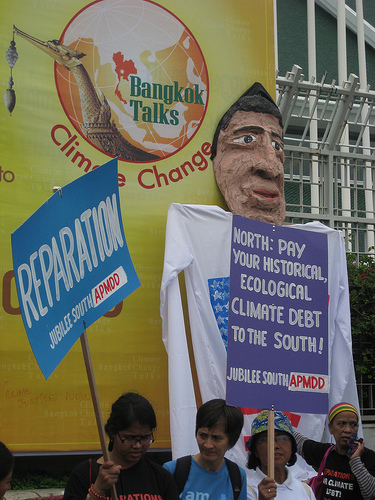Forest negotiations recently have been featuring a lot of talk about something called “sustainable forest management,” or in climate policy parlance, SFM.
Because it contains the word “sustainable,” this term conjures up images of nice standing forests, perhaps occasionally harvested by indigenous peoples to make “sustainable” furniture or artisanal paper for those of us in the United States.
However, here in Bangkok, SFM is at the heart of a fierce debate over what the fundamental shape of the climate change treaty will be.
Environmentalists are lining up against industry interests in a debate over the inclusion of SFM in the treaty language. Who ultimately wins will determine whether or not the climate change treaty will actually reduce the 20 percent of global greenhouse gas emissions that stem from forests by providing support to keep tropical forests standing; or will the treaty incentivize a massive logging boom that will focus on maintaining so-called carbon stocks (the industry word for forests) – allowing corrupt elites in tropical countries to continue business-as-usual exploitation of natural resources.
Part of the problem with SFM is that it’s unclear what the term actually means. Peter Wood of Global Witness, co-author of a new report on the subject, told me that, “SFM the most abused word in forestry. It’s been used and abused to describe some of the nicest forestry in the world to some of the most damaging forestry in the world. And there is nothing you can do to prove or disprove the term.”
Born in 1992 at another UN environmental conference, SFM was made purposely ambiguous as part of an effort to broker a forest policy compromise. In the intervening years, the logging industry has embraced the term, using it as a justification to clear-cut of thousands of hectares by leaving a few clumps standing, or to greenwash the conversion of ancient forests into tree plantations.
“SFM is a European model of nice neat rows of trees that will be managed like a crop,” continues Wood. “We’re talking about the difference between antiques and Ikea.”
That difference between “managed” stands of trees and natural forests makes a huge difference in terms of carbon accounting. According to an earlier Global Witness report, even the most benign forms of commercial logging can release up to 80 tons of carbon per hectare. Logged forests are also more susceptible to forest fires. During the El Niño events in the late 1990s, 60 percent of logged forests in Indonesian Borneo went up in smoke, sending massive amounts of carbon into the atmosphere. Only 6 percent of primary forest burned.
In the short-term, SFM may bring more profits, but it certainly won’t be sustainable. Allowing SFM into the climate change treaty opens up the possibility that money meant to protect forests and reduce emissions might actually end up subsidizing forest destruction and thus, increased carbon emissions.
It will also certainly result in a loss of biodiversity as habitats are destroyed and cultures are lost, along with the natural forests that have housed them for generations. This would be a betrayal of the original intention of the UN climate process, and a tragedy for forest peoples around the world.


